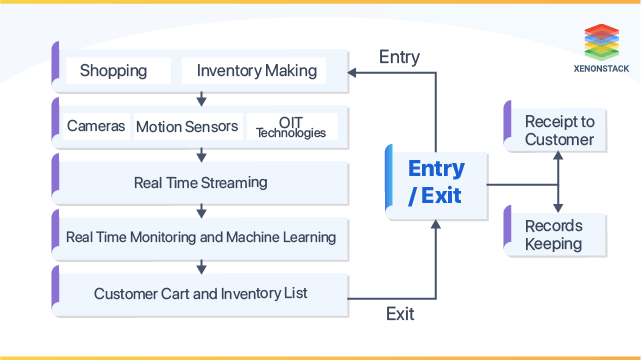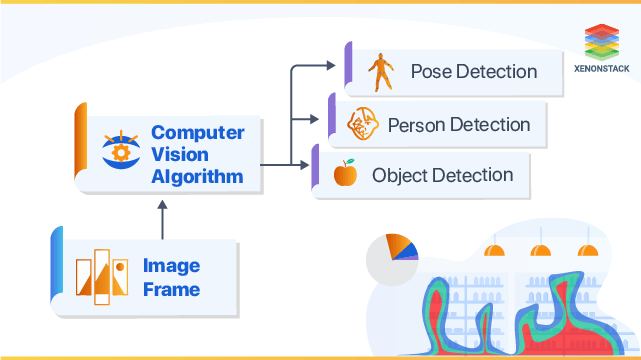What is Real-Time Store Monitoring?
Real-Time Store Monitoring plays a crucial role in identifying the most valuable customers for any company. Retail stores have always prioritized enhancing customer convenience, especially in the face of intense competition. Understanding customer preferences and buying patterns is now more important than ever in the retail industry. While traditional in-store retailing treats all customers the same, online retail spaces offer personalized shopping experiences. Retail stores implement Real-Time Store Monitoring to create a more successful in-store sales experience.
This innovative approach utilizes technologies like Machine Learning and Deep Learning to give customers an unprecedented shopping experience. Shoppers can now skip the checkout lines and walk out with their purchases, eliminating the need for billing and waiting in queues. At the same time, store officials gain the power of Real-Time analytics and reduce their reliance on the human workforce.
60% of enterprise business leaders say customer analytics is extremely important today, jumping to 79% by 2020 with a key driver being personalization at scale Source - How To Improve Customer Experiences With Real-Time Analytics
The Need for Real-Time Store Monitoring
One of the most frustrating experiences for shoppers in retail stores is waiting in long checkout queues. According to a report by A Garbango, adults spend a staggering 32.89 days of their lives standing in grocery store lines. Imagine how wonderful it would be if customers could pick up their bags and leave the shop within moments of making their purchases, without having to endure lengthy queues. This would greatly enhance the shopping experience for customers and provide store owners with valuable insights through Real-Time Store Monitoring, such as identifying popular items and monitoring stock levels. This would undoubtedly positively impact the economy, as discussed further below.
What are the Benefits of Real-Time Store Monitoring in Retail?
Listed below are the economic benefits of Real-Time Store Monitoring in Retail:-
Real-time store Monitoring can eliminate the need for certain store employees, such as cashiers and inventory managers. By implementing this technology, retail stores can operate more efficiently and reduce their reliance on the human workforce.
-
Gather a wealth of data from the Real-Time Store Monitoring platform and utilize it to make informed and strategic business decisions. For instance, identify which store sections are experiencing high demand for certain items in real-time, allowing for personalized recommendations to shoppers based on AI algorithms implemented in the backend.
-
Labour savings help us know the amount of labour required to complete tasks.
Real-time store Monitoring saves the most valuable commodity: shoppers' time. It also contributes to the economy and allows retail owners to make quick business decisions. Read More about The Kubecost – Cost Analysis with Kubernetes Monitoring
How will Real-Time store Monitoring work?
As the figure below explains, the proposed architecture for Real-Time Store Monitoring will use Machine Learning. Analyze the customers using live streaming cameras fed to Deep Learning algorithms to make customer purchases and inventory updates in Real-Time Store Monitoring.
The key KPIs are as follows:
-
Customer Traffic Analysis
-
Staff Performance
-
Customers Behaviour in the store for future recommendations

The solutions needed to the problems in Real-Time Store Monitoring:
-
Person Detection: Detects the shoppers based on their shopping cart in the backend.
-
Object Recognition: We need to recognize the items taken by shoppers.
-
Pose Estimation: Detect the shoppers' movements, whether putting their items in their bags or just taking them to inspect them.
-
Motion Sensors and Camera Feed collaboration: To make decisions, we must collaborate with the camera and motion sensors.
How can Computer Vision help?
Implementing state-of-the-art deep learning techniques and computer vision algorithms like convolutional neural networks (CNNs) can effectively tackle these computer vision challenges. The training and performance evaluation of these algorithms will be customized to meet the specific requirements of each retail store, considering factors such as store size and customer footfall. By harnessing these cutting-edge technologies, retailers can gain valuable insights and optimize their operations to enhance the shopping experience for their customers. Explore more about Performance Monitoring Tools and Management.
Why is Real-Time Store Monitoring in Retail Important?
Streaming Services
High-quality cameras will be required to live stream the store's activities and forward the feed to the Computer Vision algorithm.
The Motion Sensors
Motion Sensors will be required to trigger the activities when unusual behaviour is observed that may need a response.
Access to GPUs for computing
This is the most important requirement for training any Machine Learning algorithm, and in this case, as the process will be in real-time, high-capacity GPUs will be required to perform the model training and job scoring.
Cloud Access for storing the data
Cloud access is required to store model artefacts and data.
Real-Time Store Monitoring Use-Case
Nowadays, businesses seek innovative ideas to transform their business for better growth and digital development. Here is the use case of Amazon Go and how they transformed it: Amazon Go has completely revolutionized the retail industry with its groundbreaking implementation of Real-Time Store Monitoring. By requiring customers to install their app for entry, Amazon Go stores offer a seamless shopping experience. Once inside, customers can freely browse and select items without any hassle. The app integrates the billing process, allowing customers to pick up the items they want and leave the store. In just 30-40 minutes, customers receive detailed billing information via email. This innovative approach enhances the shopping experience and highlights the immense potential of Real-Time Store Monitoring in transforming the retail industry. Explore more about Real-Time Analytics Services on AWS.
How does Amazon increase the shopping experience?
The Amazon Go store revolutionizes the shopping experience by eliminating checkout lines and repacking procedures, providing customers with a 33% increase in convenience.
-
Quick access to groceries and convenience goods
-
Turn-style entry: The consumer enters via the Amazon app on the smartphone.
-
The consumer walks around the store, picks up items, adds them to the bag, and shops normally.
-
Consumers Exit
Conclusion of Real-time Store Monitoring
The Real-Time Store Monitoring solution, powered by advanced Deep Learning and Machine Learning technology, offers tremendous value to the retail industry. It empowers retailers to unlock invaluable insights into consumer preferences, buying patterns, and demographic characteristics, all gathered through cutting-edge technologies. As the retail sector continues to evolve, there is vast potential for further development, making Real-Time Store Monitoring even more adaptable and enhancing the shopping convenience for customers. We highly recommend connecting with our experts to explore the full potential of Real-Time Store Monitoring in revolutionizing your retail business.
- Explore Real-time Streaming Data Visualization
- Read here about IoT Analytics Platform for Real-time Data Ingestion
Next Steps in Real-Time Store Monitoring
Talk to our experts about implementing compound AI systems. Discover how industries and departments use Decision Intelligence and Real-Time Store Monitoring to become decision-centric. Utilizes AI to automate and optimize IT support and operations, improving efficiency and responsiveness.
.webp?width=1921&height=622&name=usecase-banner%20(1).webp)



